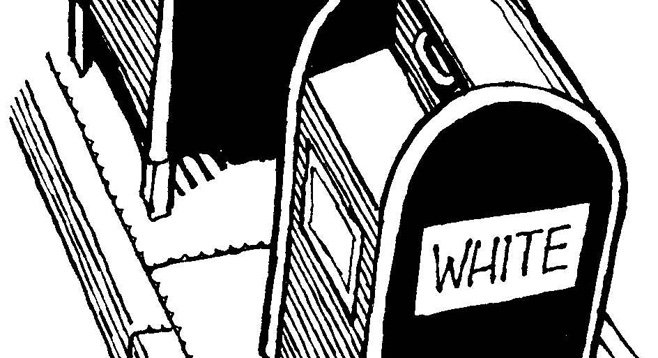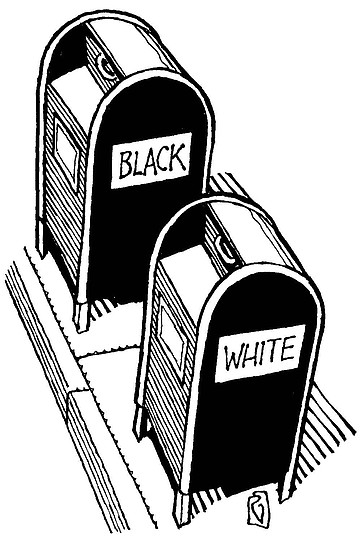 Facebook
Facebook
 X
X
 Instagram
Instagram
 TikTok
TikTok
 Youtube
Youtube

Hello Matt:
I’ve always wondered where the term “blackmail” came from. Is it the opposite of white mail, since most envelopes are white? Why would blackmailers use black paper to write their ransom notes or whatever? If you get something black in the mail, I’d think you wouldn’t open it because you know it’s something bad.
— Anonymous, via email

Yeah, though you might miss a few invitations to Halloween parties, I s’pose. “Blackmail” is a trickety trickster, though. The word sends leximaniacs off in wrong directions right from the start. The word has nothing to do with the postal service or metal suits and only a bit to do with “black.” So, back, back we go to the grim days of the 16th Century in the dampness that is Scotland. Tough guys owned land, most of us tilled it. For that privilege, we paid rent. In the vocabulary of the day, that rent was known as “mail,” a contract. Has its roots in some weird Norwegian word that nobody cares about anymore. So there we are paying our mail in the traditional way, with silver coins. Word histories say the system was nicknamed “white mail.” I dunno...did white mail precede blackmail? Anyway, with all the time the clan chiefs had on their hands, they dreamed up another money-grabbing system that we’d call protection. You don’t pay this extra fee, we destroy your crops, grab the land, generally do lots of bad stuff to you and yours. This, it’s said, immediately became known as black mail — black, as in the dark side of human nature. Unlike a lot of made-up terms, this one was useful enough to survive by word-of-mouth and in print, though its meaning morphed over the years.
Heymatt:
What ever happened to the county fair’s beauty pageant to pick the Fairest of the Fair? She was an old standby for most of my life.
— Bob, telephonically
Hey, yeah, you’re right. Haven’t seen her around lately but never missed her until you asked. The Fairest (a.k.a. Miss San Diego County) was a big deal at the county fair every year since the 1930s. If she survived a bunch of later pageants, the winner had a chance to become Miss Universe or Miss Crab Nebula or something like that. Story goes that in 2003 and again in 2004, disputes broke out over the contest rules, and there was a big whoop-de-doo over who the winners really were. They resolved the arguments behind the scenes with a minimum of hair-pulling and no threats of sash strangulations. But some of the glitter was gone from the tiara.
At about the same time, the fair’s name and administration changed, so I guess it was seen as a good time to hustle her majesty off the stage, too. It reportedly cost about $85,000 a year to host the shindig, anyway.
One of the Fairest’s main jobs was to appear on TV and radio and at shopping malls as the official comely fair promoter. But in this world of spin control, who can afford to leave a major PR function in the hands of a high school senior with puffy hair? The fair’s PR function has been reassigned, but they’ve never replaced the Fairest’s cheese factor.
Hello Matt:
At first I wondered about “spitting image,” and that reminded me of “nothing to sneeze at.” Why do we say these?
— Bonnie and her dog
We shouldn’t have sent the word nerds three questions in a single week. We had to post guards outside their windows to make sure they didn’t try to escape when they heard us coming. They did spend about 15 minutes making paper airplanes out of Bonnie’s inquiry and sailing them over the elves’ heads but finally got down to it. Spitting image: Apparently there have been a bunch of spit-based expressions that mean “an exact likeness between two people.” Comes from the idea that one person spit out the second image in his own likeness. The original expression was “spitten image,” an image that had been spit out. Our forebears were not always clever thinkers.
At least with “nothing to sneeze at” we have a good plot and a cast of goofy characters — the bygone upper crust. In 17th-century England, sneezing became quite the fad, probably helped along by the import of tobacco. With brandies around the fireplace, snooty dudes huffed and sneezed away the evening. Sneezing, they believed, cleared the head and stimulated the brain. With snuff we could sneeze at will and always stay at the top of our game. But, as usual, men turned the whole thing into a competition, and soon enough being sneezed at was a personal insult. “Achoo, sir, the point you’re making is stupid.” “M’lord, my words are nothing to sneeze at.” I think when you submit too many questions to word nerds, this is the kind of junk you get back.


Hello Matt:
I’ve always wondered where the term “blackmail” came from. Is it the opposite of white mail, since most envelopes are white? Why would blackmailers use black paper to write their ransom notes or whatever? If you get something black in the mail, I’d think you wouldn’t open it because you know it’s something bad.
— Anonymous, via email

Yeah, though you might miss a few invitations to Halloween parties, I s’pose. “Blackmail” is a trickety trickster, though. The word sends leximaniacs off in wrong directions right from the start. The word has nothing to do with the postal service or metal suits and only a bit to do with “black.” So, back, back we go to the grim days of the 16th Century in the dampness that is Scotland. Tough guys owned land, most of us tilled it. For that privilege, we paid rent. In the vocabulary of the day, that rent was known as “mail,” a contract. Has its roots in some weird Norwegian word that nobody cares about anymore. So there we are paying our mail in the traditional way, with silver coins. Word histories say the system was nicknamed “white mail.” I dunno...did white mail precede blackmail? Anyway, with all the time the clan chiefs had on their hands, they dreamed up another money-grabbing system that we’d call protection. You don’t pay this extra fee, we destroy your crops, grab the land, generally do lots of bad stuff to you and yours. This, it’s said, immediately became known as black mail — black, as in the dark side of human nature. Unlike a lot of made-up terms, this one was useful enough to survive by word-of-mouth and in print, though its meaning morphed over the years.
Heymatt:
What ever happened to the county fair’s beauty pageant to pick the Fairest of the Fair? She was an old standby for most of my life.
— Bob, telephonically
Hey, yeah, you’re right. Haven’t seen her around lately but never missed her until you asked. The Fairest (a.k.a. Miss San Diego County) was a big deal at the county fair every year since the 1930s. If she survived a bunch of later pageants, the winner had a chance to become Miss Universe or Miss Crab Nebula or something like that. Story goes that in 2003 and again in 2004, disputes broke out over the contest rules, and there was a big whoop-de-doo over who the winners really were. They resolved the arguments behind the scenes with a minimum of hair-pulling and no threats of sash strangulations. But some of the glitter was gone from the tiara.
At about the same time, the fair’s name and administration changed, so I guess it was seen as a good time to hustle her majesty off the stage, too. It reportedly cost about $85,000 a year to host the shindig, anyway.
One of the Fairest’s main jobs was to appear on TV and radio and at shopping malls as the official comely fair promoter. But in this world of spin control, who can afford to leave a major PR function in the hands of a high school senior with puffy hair? The fair’s PR function has been reassigned, but they’ve never replaced the Fairest’s cheese factor.
Hello Matt:
At first I wondered about “spitting image,” and that reminded me of “nothing to sneeze at.” Why do we say these?
— Bonnie and her dog
We shouldn’t have sent the word nerds three questions in a single week. We had to post guards outside their windows to make sure they didn’t try to escape when they heard us coming. They did spend about 15 minutes making paper airplanes out of Bonnie’s inquiry and sailing them over the elves’ heads but finally got down to it. Spitting image: Apparently there have been a bunch of spit-based expressions that mean “an exact likeness between two people.” Comes from the idea that one person spit out the second image in his own likeness. The original expression was “spitten image,” an image that had been spit out. Our forebears were not always clever thinkers.
At least with “nothing to sneeze at” we have a good plot and a cast of goofy characters — the bygone upper crust. In 17th-century England, sneezing became quite the fad, probably helped along by the import of tobacco. With brandies around the fireplace, snooty dudes huffed and sneezed away the evening. Sneezing, they believed, cleared the head and stimulated the brain. With snuff we could sneeze at will and always stay at the top of our game. But, as usual, men turned the whole thing into a competition, and soon enough being sneezed at was a personal insult. “Achoo, sir, the point you’re making is stupid.” “M’lord, my words are nothing to sneeze at.” I think when you submit too many questions to word nerds, this is the kind of junk you get back.
Comments